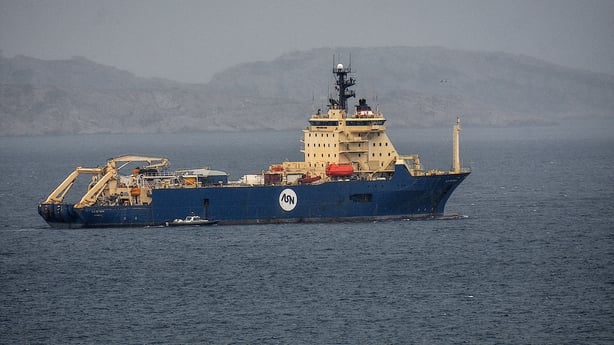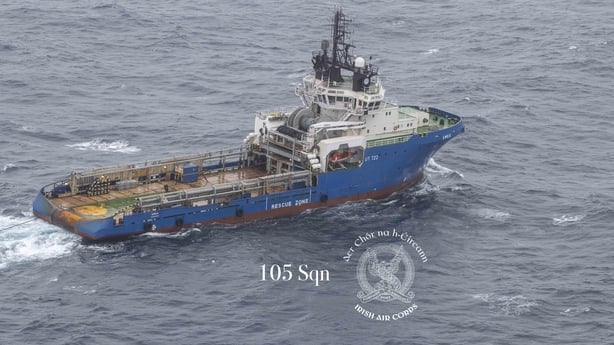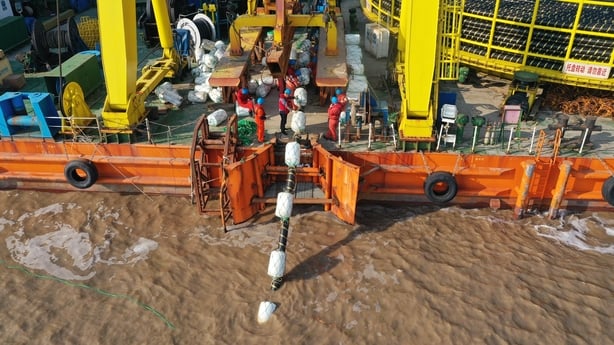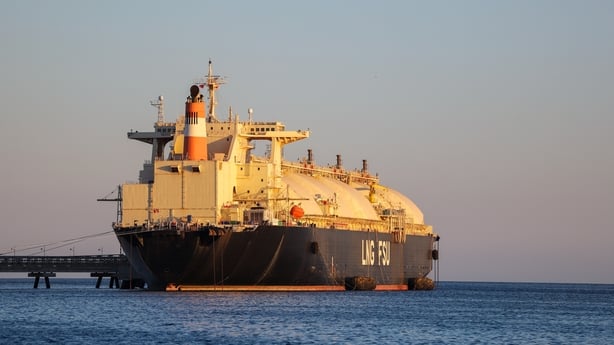Sesimbra is described by the Portuguese Travel Guide as "an attractive fishing town and popular tourist resort…set on a curving turquoise bay just 40km south of Lisbon" where visitors can enjoy the local swordfish "cooked to perfection" on pavement charcoal grills.
For two weeks last September those visitors may have noticed naval activity off the coast. Or, perhaps not, as much of it might have been underwater.
In fact, Sesimbra was host to the biggest ever NATO-supported naval exercise involving underwater drones.
It is understood that, for the first time, Irish personnel were present.
The exercises, known as REPMUS, have been hosted by the Portuguese navy since 2004. September’s event involved 900 civilian and military personnel, multiple naval and warfare command centres, 11 warships and six trial ships. Fifteen NATO countries took part.
"The Irish Navy were observers for REPMUS last year," said one source familiar with the exercise.
"The aim of the exercise is to bring navies and industry together to operate and experiment with mainly autonomous systems. The Irish Navy own autonomous underwater vehicles, so it is a unique opportunity to see what other navies, big and small, are developing, also to build relationships within the underwater community, and see new technology and sensors which are coming online."
With the attack on the Nord Stream gas pipelines, and the growing clamour over alleged Russian efforts to target underwater data cables, the future of seabed defence appears to be robotic.

NATO’s research and development centre joined the REPMUS exercises in 2014, and in 2019 its Maritime Unmanned Systems Initiative (MUSI) began playing a key role.
Essentially, participants in last September’s exercise were testing unmanned submersibles with a command and control network, ensuring the interoperability of national systems and their ability to communicate with manned platforms below, on and above the water.
The Irish presence, while minimal, is evidence of the Government’s growing interest in PESCO, the EU’s platform to facilitate member states in co-developing military systems.
Ireland’s involvement in PESCO projects has increased dramatically.
According to official figures, 18 months ago Ireland was an observer in only one project and a participant in another.
Now Ireland is participating in four projects and is an observer in a further 19. With 68 PESCO projects in total that means Ireland is involved in nearly one third of all operations.
One is the Belgian-led mine clearance project known as MAS MCM, which joined the Portuguese naval exercises in September (hence the Irish presence).
The project claims to deliver "a world-class mix of (semi-) autonomous underwater, surface and aerial technologies for maritime mine countermeasures".
Is Ireland involved in this project because of sea mines?
Not exclusively. While World War II mines are still a hazard to shipping, the interest is understood to be broader, in particular how to enhance "situational awareness" in the maritime domain. Part of that involves how to protect undersea cables.
"While the title of the project is Mine Counter Measures," said a naval source, "it is actually about using autonomous underwater systems and robotics to deal with underwater threats, be they mines or threats to critical seabed infrastructure.
"The aim is to do everything remotely, removing the ships and the people from the danger area. This is a great opportunity for the Irish Navy to see which direction the bigger navies and industry are headed. The Irish Navy have some of these systems, so exposure to these new concepts is very valuable."
European navies have tended to compartmentalise seaborne threats. Mine clearance and anti-submarine warfare were dealt with by separate navy units which had their own expertise and capabilities.
Deepsea activity was the preserve of exploration industries which could afford the technologies to operate at such depths.
However, the seabed has increasingly become laden with undersea cables, whether data, electricity or gas. Deep waters offered protection, but perhaps not any more.
The EU has had a maritime security strategy since the 2000s, but it largely focused on piracy and smuggling. An updated action plan in 2014 identified subsea data cables as being in need of protection, but the issue was not a priority.
In September 2018, experts from all 27 member states met at EU level to address seabed warfare.
According to one source present, there was an alarming awareness of the capabilities that Russia and China - but particularly Russia - were developing.
By June 2022, a European Parliament report warned that "due to the crucial role of undersea cables and the growing concerns around their security, it is paramount for the European Union and its member states to ensure the protection of submarine cables".
In parallel to the Russian threat, the kinds of submersible vehicles that were the preserve of the exploration industry have become cheaper and more widely available (on 24 May a Russian intelligence ship, the Ivan Khurs, was attacked in the Black Sea by a surface drone).
In the new reality, the ability to protect undersea cables is now regarded as the preserve of the defence sector, navies which are equipped with autonomous underwater vehicles.
In 2021, France launched its Seabed Warfare Strategy, which aimed at developing capabilities to take action at 6,000 metres below the surface. Italy has defined the subsea world as a military rather than a maritime domain.
It was not until the invasion of Crimea that the Russia maritime threat started to concern western military planners, in particular the threat to undersea infrastructure.
After the invasion, Moscow cut Ukrtelecom communications cables linking Crimea to the rest of Ukraine.
While Russia had long been accused of interfering in western elections through hacking and influencing operations on social media, the unglamorous subsea cable network offered a new and potentially more disruptive target.

"If attackers can damage, destroy, or merely cut power to physical internet infrastructure, such as undersea cables," wrote Justin Sherman from the Atlantic Council’s Cyber Statecraft Initiative, "they can disrupt internet communications in a target area to cause public panic and unrest, undermine economic activity, and disrupt the flow of government and citizen communications."
A new Cold War on the high seas has been brewing for some time.
In 2008, Russia embarked on a major upgrade of its navy, developing intelligence ships equipped with deep sea submersibles that could potentially disrupt undersea cables.
By 2015, NATO was warning of a more confrontational Russia contesting the maritime domain in the Baltic, Arctic and Mediterranean seas in ways not seen since the Cold War, boosting submarine production and increasing patrols by 50%.
In October 2015, based on Pentagon briefings, the New York Times reported that Russian submarines and spy ships were "aggressively operating near the vital undersea cables that carry almost all global internet communications, raising concerns among some American military and intelligence officials that the Russians might be planning to attack those lines in times of tension or conflict".
The paper claimed one Russian vessel called the Yantar, classified as an "oceanographic research vessel", was tracked by US satellites probing a cable route between the US and Cuba, equipped with two submersibles which were capable of either tapping - namely, applying sensors to gather information - or cutting fibre optic data cables.
In 2020, NATO defence ministers were briefed on the risks and the alliance began developing a strategy to counter the threat, with a new command centre based at the NATO base in Norfolk, Virginia.
The threat came home to Ireland in February 2022, just weeks before the invasion of Ukraine, when the Russian navy and airforce announced live-fire exercises off the southwest coast and within Ireland’s 200 nautical mile exclusive economic zone (EEZ).

Following protests from the Irish Government, Russia moved the operation further into the Atlantic.
However, six months later the Irish Times reported that one of the ships involved, the Marshal Ustinov, was back in Irish waters with two other Russian warships and acting suspiciously, travelling due north, then turning around and heading back the way they had come.
The fact that these movements took place near a concentration of data cables deepened suspicions. In November 2022, just two months later, internet cables linking the Shetland Isles to mainland Scotland were cut in two places. A Russian scientific research ship, the Boris Petrov, was tracked nearby when the cables were cut.
The risk to undersea cables has jolted the Irish system out of a long slumber.
Eoin Micheál McNamara, research fellow at the Finnish Institute of International Affairs, wrote for the Royal United Services Institute (RUSI) that "awareness and understanding of military-strategic issues among wider society and within the political system is often negligible.
"For most Irish politicians, supporting national defence is unlikely to create much electoral reward."
Ireland notoriously has a huge maritime area to monitor, and only six patrol vessels traditionally focused on fisheries protection, interdicting drugs shipments and search and rescue.
In 2020, the Defence Forces review warned of the growing Russian threat: "The Irish Naval service has no anti-submarine capability and its ability to deter or even detect such maritime intelligence gathering is exceptionally limited.
"Neither has Ireland got the radar, air defence, and air interdiction capability necessary to deter and monitor Russian or other aircraft entering Irish airspace without permission and instead relies on the United Kingdom’s Royal Air Force to carry out this task on its behalf."
The fact that Ireland hosts so many leading technology and internet companies, all of whom rely on, or indeed own, subsea data cables, meant this threat had to be taken seriously, the review stated.
"Hundreds of cables criss-cross the oceans," wrote Garrett Hinck of Columbia University in the Lawfare Blog in 2018. "They provide the connectivity that allows Microsoft to keep major data centers in Ireland and to have that data nearly instantly accessible to US customers."
The Report of the Commission on the Defence Forces, published in February 2022, acknowledged that "neighbouring countries in Europe have a keen interest in our capacity to police our air and maritime areas of responsibility, including in the politically sensitive area of fisheries, and to protect our national security from external incursion by sea or air."
'A real challenge for navies'
It recommended that if Ireland were to increase its capabilities to what is termed Level of Ambition 2, that would mean a minimum of nine modern ships with "enhanced air, surface and sub‐surface search capabilities, supported by appropriate modern technology including ISR (Intelligence, Surveillance and Reconnaissance) and unmanned ship‐borne RPAS (Remotely Piloted Aircraft System) providing tactical airborne capabilities.
"The fleet’s sub‐surface capabilities should allow the Naval Service to monitor activity in the vicinity of sub‐sea cables."
However, increasing the number of patrol vessels is one thing; having a greater vision of what is happening on the seabed is another.
"This is a real challenge for navies," said one source familiar with emerging threats. "Developing a clear picture of what is happening on the surface of the sea can be difficult, particularly when your area of responsibility is as large as Ireland’s.
"The Irish Navy has put a huge emphasis, and has been very successful, in developing that recognised maritime picture, as a critical enabler to carrying out operations. Obviously, there is a lot that can be done. But, underwater, we are virtually blind."
That may explain why PESCO projects are becoming increasingly attractive to the Government.
PESCO projects work on the basis that member states collaborate on new defence technologies in the hope that such systems will be cheaper and interoperable.
The European Defence Agency (EDA), which oversees PESCO projects, said the Portuguese exercise, coordinated in advance with NATO’s Mine Warfare Centre of Excellence in Ostend, would "take the lessons learned…[and] lead to closer cooperation with the industry for further testing of new technologies and their interoperability."
Irish sources downplayed the increased engagement in PESCO as being linked to the war in Ukraine or the Russian maritime threat.
They said the spike in involvement is rather a reaction to the "striking capability gaps" identified by the Report of the Commission on the Defence Forces.
In its response to the report in March 2023, the Government recommended deeper involvement in PESCO projects. Of the 19 where Ireland has observer status, three relate to maritime surveillance and protection.
Some PESCO projects run for five years, but for those where more complex defence systems are being developed, such as underwater drones, the projects can last for a decade.
Officials say the Belgian-led project on mine countermeasures, which runs to 2030, is about being part of the long game, knowing where and how defence capabilities are going to be developed, and being part of that process when it is in Ireland’s interests.
"High end capability takes a long time to develop," said one source familiar with PESCO projects. "So, the more complex the capability that you're trying to develop, the longer the time frame."
Ireland is also a participant in a Greek-led project on maritime surveillance, due to complete its work in 2025.
Govt giving 'deep consideration' to PESCO participation - Varadkar
In March this year, Irish naval divers joined their US, Greek, Belgian and Romanian counterparts in a NATO-supported exercise off Crete focusing on Autonomous Underwater Vehicles (AUVs) and "utilising Side Scanner Sonar technology".
According to a Naval Service Facebook page, this was all about building on the navy’s sub-surface capabilities and "protecting Ireland’s critical maritime infrastructure".
Last month the EU approved an Italian-led Critical Seabed Infrastructure Protection (CSIP) project designed to make "best use of current, and the development of future, underwater assets".
Sources said this project was being examined by Defence Forces HQ and that ministerial approval for Ireland to join as an observer was "likely".
For Ireland to be an observer on PESCO projects, ministerial consent is required, whereas full participation requires cabinet approval.
On 1 June, Taoiseach Leo Varadkar confirmed that the Government was giving "deep consideration" to participating in PESCO or NATO-led initiatives.
Speaking in Moldova, he said: "Because we are an island nation, our seas are seven times greater than our land area and going through those seas are a lot of really important infrastructure [and] communications cables that connect Ireland to the world and Europe to North America."
It is estimated that some 550 cables, which can transmit more data and faster than satellites, are laid by private companies globally in deep waters. Stretching 1.4 million km, they carry 99% of global internet traffic, including trillions of euro in financial transactions.
It is the cables which connect the EU to North America which have the strongest cumulative transmission capacity and which have attracted the most attention.
It is believed three-quarters of such cables pass through or near Irish waters (four physically connect to Ireland).
Most cable disruption is caused by seismic or weather-related factors, as well as bottom-tending fishing and dredging. Other factors include anchoring accidents, oil and gas exploration and offshore renewables.
However, the European Parliament report warned that the military threat must be taken seriously.
"Protecting submarine cables is far too essential a domain of international politics to remain a technical addendum to security analysis," the report said.

"It concerns how our digital futures will be governed and how a global free, open, and secure circulation of data can be ensured."
But it was the attack on the Nord Stream 1 and 2 pipelines that pushed the issue of subsea infrastructure vulnerability from the theoretical into the real.
There has been rampant speculation as to the perpetrators, whether they be Russian, Ukrainian or even US actors, but none of the official investigations has yet drawn any conclusions.
Despite Russia routinely denying its maritime fleet has been involved in targeting undersea data cables, on Wednesday of this week Dmitri Medvedev, the deputy chair of Russia’s security council, was reported as saying: "Based on the evidence of Western complicity in undermining Nord Stream, Russia has no reason to refrain from destroying the enemy's cable communications on the ocean floor."
Whether destruction is what Russia has in mind, or whether the Kremlin wants to demonstrate that it can destroy vital infrastructure in the event of a wider conflict, is the subject of ongoing speculation by military and open source intelligence experts.
But the need to know what is going on at oceanic depths - not just in territorial waters - is exercising EU policy makers.
At an IBEC conference in Dublin in 2022, the EU’s competition commissioner Margrethe Vestager said: "Ireland has a responsibility as does everyone else. No-one can be a weak link of our chain of protection."
In February, NATO announced a Critical Undersea Infrastructure Coordination Cell. The next month NATO’s deputy secretary general Mircea Geoană told an IIEA meeting in Dublin that Ireland partnering with NATO on this issue would make sense.
"As an advanced knowledge-based economy, with thriving technology, pharmaceutical, biotech, and financial sectors, ensuring Ireland’s resilience will be critical in the years ahead," he said.
The EU has adopted a Critical Entities Resilience directive which included a commitment by member states to identify essential energy and communications infrastructure and to complete a stress test on such networks by the end of this year (capitals must also complete a national strategy by the end of 2026).
In December, following the Nord Stream sabotage, the EU adopted a plan to accelerate resilience through "preparedness, response and international cooperation".
That includes cooperation with NATO.
In March this year, the EU and NATO launched a task force on strengthening critical infrastructure, including an assessment of where the risks are, a report on which will be presented to NATO leaders at the summit in Vilnius next month.
Entering new territory for Ireland
Unlike many capitals, Ireland has no history of cooperating with other member states in developing defence capabilities and coordinating resources.
The Belgian navy has a long tradition of cooperating with their Dutch counterparts. The Nordic Defence Cooperation (NORDEFCO) brings together Denmark, Finland, Iceland, Norway and Sweden to develop capabilities more cheaply, and the same is true for the central and eastern European Visegrad countries.
The Government, however, appears to have embraced PESCO projects in order, for the first time, to follow suit. Often, Ireland will be an observer simply to learn what way capabilities are going and whether it will suit the state to be a full participant.
In 2019, Greece, France, Italy and Spain embarked on a PESCO project to develop a new European Patrol Corvette (EPC).
The aim is to build in interoperability, meaning all participants will have the same maintenance and training perspectives, not to mention economies of scale when fitting the vessels with the latest sonar and sensor technology.
Ireland is an observer on that project.
The hard reality is that to replace a multi-role naval patrol vessel, as recommended in the Government White Paper on Defence in 2015, will cost upwards of €300 million, a huge chunk given other budgetary needs, but not much in the broader European defence expenditure.
As the consultative forums on Irish defence and security get underway next week, a thorny question will be how far Ireland wants to embrace EU PESCO projects, especially given the ever closer relationship the EU is developing with NATO on defending critical maritime infrastructure.
While PESCO participation does not replicate the NATO requirement for members to spend 2% of GDP on defence, it does come with 20 binding commitments.
These include spending more and better on defence, supporting the European defense industry, spending on research and innovation, engaging with the European Defense Fund (EDF), which promotes cooperation among member states to boost R&D in the defence sphere.
Meanwhile, the interconnectedness of all sorts of maritime infrastructure, and the fact that it occurs in international waters, means that the vulnerability is potentially broad, the costs of mitigation considerable, and where responsibility lies (private or public) uncertain.
With the invasion of Ukraine, Europe has been scrambling to shift away from Russian gas, replacing it with LNG. That in turn will mean port-based storage tanks requiring their own maritime protection strategies.

In Moldova, Mr Varadkar also referred to the gas and electricity interconnectors with the UK, and the new interconnector with France, saying: "I don’t think we can protect these on our own."
A Defence Forces spokesperson pointed out that enhanced maritime patrolling of the Irish Sea near "priority offshore energy infrastructure" began last year involving air and naval platforms, and is ongoing, and that engagement continues with the Department of the Environment, Climate and Communications on protecting offshore energy infrastructure and data cables.
The Naval Service currently has six vessels, including four operational P60 class vessels. One, the LÉ Niamh, a P50 class ship, is currently undergoing a refit due to be completed by the end of the year, while a second P50 vessel, the LÉ Róisín, is in "operational reserve".
In addition, the Government has purchased two inshore patrol vessels from New Zealand to replace the LÉ Orla and LÉ Ciara and they are currently undergoing works and crew training.
These new vessels will "introduce certain new electronic warfare and intelligence gathering capabilities and enhance the patrol profile of the Naval Service on the east and southeast coast," according to a Defence Forces statement.

The statement said the Naval Service retains capabilities that allow for underwater search and surveying, including an underwater remotely operated vehicle (ROV) and a magnetometer system.
The Government believes the Level of Ambition 2 recommendation of the Report of the Commission on the Defence Forces should enhance subsurface capabilities to monitor subsea cables.
The spokesperson added that further capabilities include multi-beam echo sounder systems, currently under development.
A project is underway to retrofit the four P60 class offshore patrol vessels with multi-beam echo sounders, including hull mounted sonar.
"The capability will provide the Naval Service with the ability to locate and profile obstructions and wrecks on the seabed," the statement added.
The Defence Forces say the Air Corps Maritime Patrol Squadron carries out aerial surveillance of Ireland’s exclusive economic zone using two CASA 235 maritime patrol aircraft, "equipped with state-of-the-art surveillance and communication equipment".
These planes are due to be replaced with two C295 Maritime Patrol Aircraft, contracted to Airbus Defence and Space in December 2019, and are expected to be delivered later this month and in September.
They will be equipped with "multiple LiDAR shallow subsurface detection systems combining airborne topography, bathymetry surveying and high-resolution imaging".
Ultimately, the Irish Defence Forces are - like other EU member states - scrambling to understand and deal with the alleged Russian threat. When it comes to the seabed, a new robotic race is underway.







